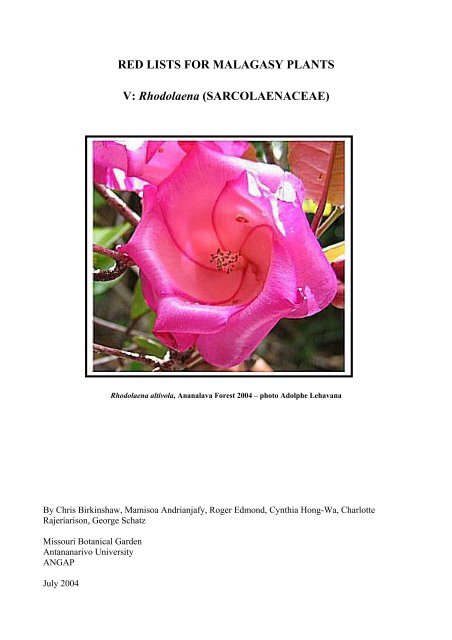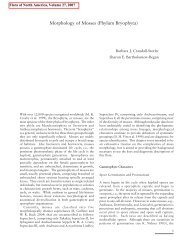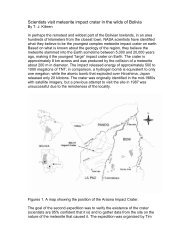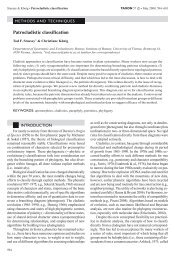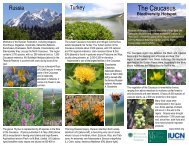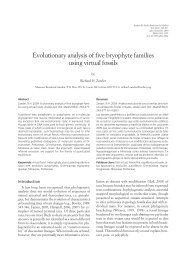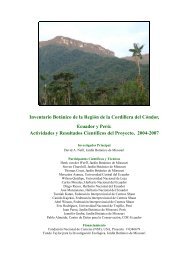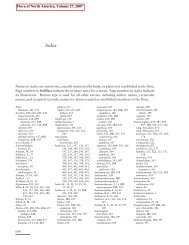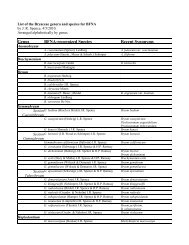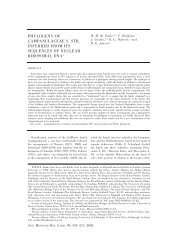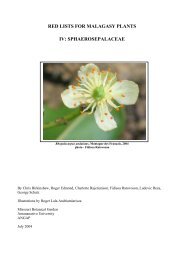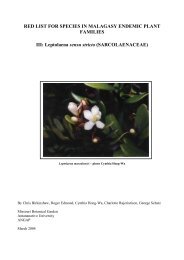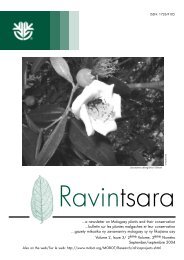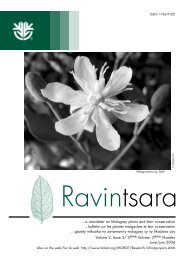red lists for malagasy plants - Missouri Botanical Garden
red lists for malagasy plants - Missouri Botanical Garden
red lists for malagasy plants - Missouri Botanical Garden
You also want an ePaper? Increase the reach of your titles
YUMPU automatically turns print PDFs into web optimized ePapers that Google loves.
RED LISTS FOR MALAGASY PLANTS<br />
V: Rhodolaena (SARCOLAENACEAE)<br />
Rhodolaena altivola, Ananalava Forest 2004 – photo Adolphe Lehavana<br />
By Chris Birkinshaw, Mamisoa Andrianjafy, Roger Edmond, Cynthia Hong-Wa, Charlotte<br />
Rajeriarison, George Schatz<br />
<strong>Missouri</strong> <strong>Botanical</strong> <strong>Garden</strong><br />
Antananarivo University<br />
ANGAP<br />
July 2004
INTRODUCTION<br />
Nowhere in the World can rival Madagascar in terms of the diversity and uniqueness of its flora.<br />
Estimates of the total number of plant species in the country continue to climb and now it is thought<br />
that at least 13,000 species of higher plant grow in the country (pers. comm. P. Phillipson). This<br />
remarkable diversity is especially important given that nearly all these species (around 90% - Schatz<br />
1999) grow only in Madagascar. Sadly Madagascar’s exceptional flora is highly threatened and an<br />
alarming number of plant species are now on the very brink of extinction. We must now choose<br />
whether to make strenuous ef<strong>for</strong>ts to conserve the Malagasy flora or accept, within the next few<br />
decades, the loss of a large number of plant species. Now is the last chance to make this choice.<br />
An important part of effective conservation is prioritization: the relatively small amount of money<br />
available <strong>for</strong> conservation must be used where it will have most impact. To assist with the<br />
prioritization of conservation actions <strong>for</strong> the Malagasy flora a series of documents will be produced<br />
containing risk of extinction estimates <strong>for</strong> species in selected Malagasy plant families.<br />
The research presented here was conducted as a collaborative project between <strong>Missouri</strong> <strong>Botanical</strong><br />
<strong>Garden</strong> (MBG), Antananarivo University and Madagascar’s National Association <strong>for</strong> the<br />
Management of Protected Areas (ANGAP).<br />
METHODS FOR ESTIMATING RISK OF EXTINCTION<br />
The identification of the species with the highest priority <strong>for</strong> conservation action is based on<br />
estimates of the likelihood that they will become extinct in the next few decades. However be<strong>for</strong>e<br />
the risk of extinction of a species can be investigated it is necessary to ensure that it has been<br />
delimited using a taxonomic framework that closely reflects the real distribution of variation (that in<br />
turn reflects underlying evolutionary history) within the genus/family to which the species belongs.<br />
Thus, each taxon included in this series of <strong>red</strong><strong>lists</strong> has been subject to a recent taxonomic revision.<br />
In<strong>for</strong>mation on the risk of extinction of each species was obtained from the analysis of its<br />
distribution and from observations made in the field. Most of this work was conducted by<br />
Malagasy students as part of their DEA (= Masters) studies. Species distribution was estimated<br />
using geo-referenced locality data obtained from herbarium specimens in the five herbaria (K, MO,<br />
P, TAN, TEF) with large holdings of Malagasy <strong>plants</strong>. Most recent herbarium specimens include<br />
precise longitude and latitude coordinates of the collection location obtained using a GPS, but many<br />
older specimens do not, necessitating post facto allocation of coordinates by locating the collection<br />
site on maps with the aid of MBG’s Madagascar gazetteer (available on line at<br />
(http://www.mobot.org/MOBOT/Research/madagascar/gazetteer). The collection sites were<br />
mapped and analyzed using ArcView Geographic In<strong>for</strong>mation System (GIS) software. The<br />
resultant species distribution was quantified in terms of extent of occurrence, area of occupancy,<br />
and number of subpopulations. The analysis of each species’ distribution in relation to various<br />
environmental base maps provided in<strong>for</strong>mation on the habitat of the species in terms of geology,<br />
vegetation type, bioclimate and elevation.<br />
In<strong>for</strong>mation on the habitat, abundance, pollination, seed dispersal, regeneration, threats, uses and<br />
vernacular name <strong>for</strong> each species was obtained by locating and studying at least one population in<br />
the wild. The best method of locating species proved to be with the assistance of local people living<br />
close to previous collection sites. In<strong>for</strong>mation on the vernacular name and uses of the species were<br />
also obtained from the labels of herbarium specimens.<br />
2
Further in<strong>for</strong>mation on the methods used in the study is provided in Table 1. The in<strong>for</strong>mation<br />
collected <strong>for</strong> each species is summarized in a Risk of Extinction Datasheet<br />
3
Table 1. Methods <strong>for</strong> the collection of in<strong>for</strong>mation presented in each of the data fields of the Risk of<br />
Extinction Datasheet.<br />
Species name and author: name of species according to the most recent<br />
taxonomic revision and name of author(s) who defined the species<br />
Vernacular names: from in<strong>for</strong>mation collected in the field and captu<strong>red</strong><br />
from herbarium specimens.<br />
Description: based on in<strong>for</strong>mation in the literature and our own<br />
observations of herbarium specimens and living <strong>plants</strong> in the field.<br />
Habitat:<br />
• Vegetation type: defined by observations in the field and analysis of the<br />
distribution of the species related to the vegetation map of DuPuy &<br />
Moat (1996)<br />
• Bioclimate: defined by the analysis of the distribution of the species<br />
related to the bioclimate map of Cornet (1974)<br />
• Geology: defined by observations in the field and analysis of the<br />
distribution of the species related to the geology map of DuPuy & Moat<br />
(1996)<br />
• Altitude: based on field observations and in<strong>for</strong>mation captu<strong>red</strong> from the<br />
notes accompanying herbarium specimens<br />
Biology:<br />
• Pollination: probable pollinator identified from characteristics of flower<br />
and observations in the field<br />
• Seed dispersal: probable method of seed dispersal identified from<br />
characteristics of fruit and observations in the field<br />
Uses: based on in<strong>for</strong>mation collected by interviewing local people in the<br />
field and captu<strong>red</strong> from the literature and notes on herbarium specimens.<br />
Distribution: distribution of the species represented by the<br />
locations of the collection sites of the herbarium specimens<br />
attributed to the species in the five herbaria with large<br />
collections from Madagascar. Map created using Arcview<br />
3.2 software.<br />
Herbarium specimens examined: list of herbarium specimens examined <strong>for</strong> this study<br />
Risk of extinction: based on the application of criteria presented in IUCN (2001)<br />
Conservation recommendations: our recommendations <strong>for</strong> actions to <strong>red</strong>uce the<br />
risk of extinction of the species.<br />
Observations of study population(s)<br />
Location: study site with geo-reference<br />
• Regeneration observed: presence of regeneration assumed from the presence at the<br />
site of individuals representative of all size classes.<br />
• Tolerant to disturbance: presence of regenerating populations of the species in<br />
severely degraded vegetation ( >50% of original biomass lost).<br />
• Density: average number of mature individuals of the species per ha of appropriate<br />
habitat based on counts in replicated plots or along transects.<br />
• Abundance: estimated number of mature individuals at the study site based on the<br />
density of the species at the site and an estimate of the area of suitable habitat<br />
available (abundance classes based on thresholds used in IUCN (2001).<br />
P<strong>red</strong>icted future decline:<br />
• Due to habitat loss: estimate of decline of population based on observations of<br />
tolerance of species to habitat perturbation and estimates of rate of loss of primary<br />
vegetation from (FAO 1993, Green & Sussman 1990, Steininger et al. 2002).<br />
Classes of population decline (i.e. 0-30%, ≥30-50%, ≥50-80%, ≥80%) relate to<br />
thresholds used in the IUCN (2001).<br />
• Due to exploitation or poor regeneration: in addition to loss of habitat it is possible<br />
that populations may decline because of selective exploitation or poor regeneration<br />
resulting <strong>for</strong> example from the increasing rarity of pollinators or seed dispersers.<br />
Although we were unable to quantify these factors, their possible significance is<br />
noted.<br />
Distribution attributes <strong>for</strong> total population:<br />
(These analyses made using ArcVeiw 3.2)<br />
• Extent of occurrence: estimated as the area contained within the shortest<br />
continuous imaginary boundary drawn to encompass all the collection locations <strong>for</strong><br />
the species.<br />
• Area of occupancy: estimated as the area of suitable habitat (defined in terms of<br />
vegetation type, bioclimate, altitude and geology) <strong>for</strong> the species within the extent<br />
of occurrence.<br />
• Number of subpopulations: estimated as the number of collection locations but<br />
combining locations that are separated by less than 5 km.<br />
Representation in protected areas:<br />
Protected areas are defined as National Parks (PN), Special Reserves (RS), Nature<br />
Reserves (RNI), Biosphere Reserves (RB).<br />
• Number of subpopulations: number of data points within protected areas but<br />
combining locations separated by less than 5 km.<br />
• Protected areas: list of protected areas where the species has been recorded.<br />
5
SARCOLAENACEAE Caruel<br />
(from Schatz 2001)<br />
Sarcolaenaceae is one of five families that are currently recognised as being endemic to<br />
Madagascar. It contains 8 genera and ca. 44 species.<br />
Description<br />
Hermaphrodite shrubs to large trees, often with stellate pubescence. Leaves alternate, simple,<br />
entire, penninerved or rarely pseudo-triplinerved by virtue of induplicate vernation traces, with<br />
caducous stipules. Inflorescences umbelli<strong>for</strong>m or paniculate cymes, <strong>for</strong> sometimes flowers solitary,<br />
flowers small to often large and showy, regular, 5-merous, subtended by an involucre of bracts<br />
wich are sometimes fused to <strong>for</strong>m a cup; sepals 3 (-5), imbricate; petals 5 (-6), free, or slightly fused<br />
at their base, twisted in bud; nectary disc present or not; stamens 5-numerous, sometimes slightly<br />
fused at their base into 5 fascicles, filaments slender, anthers bilocular, longitudinally dehiscent;<br />
ovary superior, 1-5-locular, style terminal, stigma 3-5-lobed; ovules 2-many per locule. Fruit a<br />
dehiscent capsule or indehiscent and somewhat woody, often surrounded partially or completely by<br />
the involucral bracts or cup; endosperm present.<br />
Key to genera of Sarcolaenaceae<br />
1. Leaves with longitudinal lines (vernation traces) on either side of the midrib as a result of folding in bud, resembling<br />
veins and thus the venation superficially triplinerved to 3-palmatinerved, rarely the traces absent (S. isaloensis)<br />
..........................................................................................................................................................Sarcolaena<br />
1'. Leaves lacking vernation traces on either side of the midrib, never superficially triplinerved or palmatinerved.<br />
2. Leaves with mixture of stellate and lepidote indument, often dense; involucre very small at anthesis, very late<br />
accrescent in fruit or not at all.<br />
3. Fruit indehiscent, surrounded by accrescent, entire involucre; ovary 2-locular ................Perrierodendron<br />
3'. Fruit dehiscent, the involucre accrescent or not, lobed; ovary 3-5-locular.<br />
4. Sepals strongly unequal, the outer 2 much smaller; petals strongly contorted in bud; ovary 3-locular;<br />
ovules 2 per locule ..................................................................................................Eremolaena<br />
4'. Sepals more or less equal; petals slightly contorted in bud; ovary 5-locular; ovules 4-6 per locule<br />
................................................................................................................................Pentachlaena<br />
2'. Leaves glabrous or with simple indument; involucre well-developed at anthesis or not, accrescent in fruit.<br />
5. Flowers with involucre well-developed at anthesis, deeply cup- or urn-shaped, partially or completely<br />
enclosing the flower in bud.<br />
6. Involucre only partially enclosing the flower in bud; stamens arranged in 5 fascicles; ovules many per<br />
locule; involucre in fruit very large, bell-like, woody, narrowly ellipsoid, thick-walled, with a circular<br />
opening at the apex, the fruit at the base .................................................................Xyloolaena<br />
6'. Involucre completely enclosing the flower in bud; stamens not in fascicles; ovules 2 (-4) per locule;<br />
involucre only slightly accrescent in fruit, not thick walled and bell-like with the fruit at the base<br />
................................................................................................................................Leptolaena (and<br />
Sarcolaena isaloensis)<br />
5'. Flowers with involucre small at anthesis, not deeply cup- or urnshaped and partially or completely<br />
enclosing the flower.<br />
7. Sepals 5, the outer 2 smaller; flowers large, pendulous, the petals showy pink-violet <strong>for</strong>ming a funnelshaped<br />
corolla; involucre late accrescent in fruit, fleshy but not viscous, lobed but never spiny<br />
................................................................................................................................Rhodolaena<br />
7'. Sepals 3; flowers small to large, petals white to cream-yellow, rarely pink, spreading, not <strong>for</strong>ming a<br />
funnel-shaped corolla; involucre strongly accrescent in fruit, viscous and fleshy, entire or laciniate or<br />
with fleshy spines....................................................................................................Schizolaena<br />
6
Rhodolaena Thouars, Hist. Vég. Iles. Austrl. Afriq.: 47. 1805.<br />
Hermaphrodite medium to large trees. Leaves alternate, simple, entire, penninerved although the<br />
secondary venation obscure, stipules very small, caducous. Inflorescences terminal, longpedunculate,<br />
pendent, flowers, large, pai<strong>red</strong>, distinctly pedicellate and subtended by very small,<br />
scale-like involucral bracts, 5-merous; sepals 5, unequal, the outer 2 very small, the inner 3 large,<br />
persistent and accrescent, coriaceous in fruit; petals 5, contorted in bud, erect and <strong>for</strong>ming a funnel<br />
at anthesis, pink-violet, very showy; disc annular; stamens 15-50, free, filaments inserted at the<br />
inner base of the disc, anthers longitudinally dehiscent; ovary 3-locular, common style long slender,<br />
stigma capitate; ovules 4-12 per locule. Fruit a large, woody, dehiscent, 3-valved capsule,<br />
surrounded by the accrescent inner sepals, the involucral bracts tardily accrescent and fleshy; seeds<br />
1-2 per locule, with abundant endosperm.<br />
Rhodolaena is distributed in humid to subhumid evergreen <strong>for</strong>est from littoral <strong>for</strong>est at sea level to<br />
1,600 m elevation. With its large, pendulous flowers with pink-violet petals collectively <strong>for</strong>ming a<br />
funnel-shaped corolla, it is among the most beautiful of Malagasy trees and deserving of cultivation.<br />
Key to species of Rhodolaena<br />
(from Schatz et al. 2000)<br />
1. Young branches and midrib of blade below usually with dense golden indument, the trichomes<br />
ca. 0.5 mm long; stipules linear to narrowly triangular, persistent............................................... R. humblotii<br />
1’. Young branches and midrib of blade below glabrous, or twig with dense brownish indument, the trichomes<br />
less than 0.1 mm long; stipules triangular, caducous.......................................................................................2<br />
2. Leaves with a rounded apex (rarely acute) and usually emarginate, sometimes with a tiny mucro ................3<br />
2’. Leaves with an acute to acuminate apex..........................................................................................................4<br />
3. Twigs usually glabrescent, and often glaucescent; leaves strongly coriaceous, the largest blade usually<br />
greater than 7 cm long (rarely less) inner sepals coriaceous (2)2.5-3.5 cm long............................ R. coriacea<br />
3’. Twigs with dense brownish indument; leaves chartaceous, the largest blade usually less than 6 cm long<br />
(rarely to 7cm) inner sepals chartaceous, not exceeding 1.8 cm long.......................................... R. bakeriana<br />
4. Leaves with secondary veins nearly perpendicular to the midvein (>80°); involucre a distinct collar at<br />
anthesis; ovary densely golden tomentose; seeds with dense white indument ...............................R. leroyana<br />
4’. Leaves with secondary veins ascending (
RISK OF EXTINCTION DATASHEETS<br />
8
Rhodolaena acutifolia Baker Risk of Extinction: Vulnerable (A3c)<br />
Vernacular names: Anjananjana, Hazompasina Conservation recommendations: a) good management of<br />
protected areas; b) inclusion of additional populations in<br />
protected areas<br />
Description:<br />
Small trees (shrubs). Twigs hairless. Stipules located either<br />
side of petiole. Leaves small/medium, narrowly<br />
elliptic/ovate, broadest around the middle, apex acuminate.<br />
Inflorescence consists of 2 flowers on a long stem. Flowers<br />
very large with 5 unequal sepals densely cove<strong>red</strong> with tiny<br />
appressed hairs, 5 bright purple-pink petals (5 cm long),<br />
many stamens with long filaments, a circular nectary disk,<br />
ovary with long style. Fruits medium, woody, densely hairy,<br />
dehiscent.<br />
Habitat<br />
• Vegetation type: low elevation evergreen <strong>for</strong>est<br />
• Bioclimate: humid<br />
• Geology: basement rocks<br />
• Altitude: 350 - 800 m<br />
Biology<br />
• Pollination: probably insects and birds (based on the<br />
characteristics of the flower and observations of bees,<br />
hornets and the sunbird (Nectarina souimanga) visiting the<br />
flowers of R. bakeriana)<br />
• Seed dispersal: the fruit is capsular and seeds apparently<br />
fall to the ground close to the parent plant<br />
Uses: Timber<br />
Distribution<br />
photo – Fidisoa Ratovoson<br />
Observations of study population(s):<br />
• Location: Anjirobe (48°57’17”E, 17°24’04”S)<br />
• Regeneration observed: yes<br />
• Tolerant to disturbance: no<br />
• Abundance: > 10,000 mature individuals<br />
P<strong>red</strong>icted future decline:<br />
• due to habitat loss: 30-50% (cause of loss = shifting<br />
cultivation)<br />
• because of exploitation or poor regeneration: decline possible<br />
because of exploitation <strong>for</strong> timber<br />
Distribution attributes <strong>for</strong> total population:<br />
• Extent of occurrence: 501 km²<br />
• Area of occupancy: 442 km²<br />
• Number of subpopulations: 6<br />
Representation in protected areas:<br />
• Number of subpopulations: 2<br />
• Protected areas: Zahamena AP<br />
Herbarium specimens examined: Madagascar : R. Baron 6086 , Baron 2427 (HT: K; IT: K(2)). Toamasina: Zahamena RNI, SF(Laibosaka) 26090<br />
(P, TEF) ; Zahamena RNI, RN(Botoalina) 3163 ; Maningory, H. Perrier de la Bâthie 2224 ; Zahamena RNI, RN 10487 ; Tsonsona, G. Cours 1553 ; Sahalangina,<br />
N.M. Andrianjafy & L.R. Andriamiarisoa 117 ; Sahalangina, M. Andrianjafy 118 ; Zahamena PN, S.T. Rakotonandrasana & F. Ratovoson 450 ; Zahamena AP,<br />
Fidy Ratovoson et al. 307 ; Zahamena AP, F. Ratovoson et al. 315 ; Zahamena RN, Simon Malcomber et al. 2513A ; Zahamena AP, S. Randrianasolo et al. 389 ;<br />
Zahamena AP, Roland Rakotondrajaona et al. 282.<br />
9
Rhodolaena altivola Thouars Risk of extinction: Critically Endange<strong>red</strong> (A3c, B1ab)<br />
Vernacular names: Voandrozana Conservation recommendations: inclusion of populations in<br />
new conservation sites<br />
Description:<br />
Small (medium) trees. Twigs hairless. Stipules located either<br />
side of the petiole. Leaves medium, ovate, with acuminate<br />
apex and rounded base; young petioles <strong>red</strong>dish.<br />
Inflorescences with 1 or 2 flowers on a long pendant stem.<br />
Flowers very large with 5 unequal glabrous sepals, 5 bright<br />
purple-<strong>red</strong> petals (5 cm long), many stamens with long<br />
filaments, a circular nectary disk, ovary with long style.<br />
Fruits large, woody, dehiscent, sparsely hairy<br />
Habitat<br />
• Vegetation type: low elevation evergreen <strong>for</strong>est, midelevation<br />
evergreen <strong>for</strong>est<br />
• Bioclimate: humid, subhumid<br />
• Geology: basement rocks, lake and alluvial deposits<br />
• Altitude: 200 - 1,000 m<br />
Biology<br />
• Pollination: probably insects and birds (based on the<br />
characteristics of the flower and observations of bees,<br />
hornets and the sunbird (Nectarina souimanga) visiting the<br />
flowers of R. bakeriana)<br />
• Seed dispersal: the fruit is capsular and seeds apparently<br />
fall to the ground close to the parent plant<br />
Uses: none reported but probably exploited <strong>for</strong> timber<br />
Distribution<br />
photo - Adolophe Lehavana<br />
Observations of study population(s):<br />
• Location: Analalava (49°47’20”E, 17°42’04”S)<br />
• Regeneration observed: yes<br />
• Tolerant to disturbance: no<br />
• Abundance: 1,000 - 2,500 mature individuals<br />
P<strong>red</strong>icted future decline:<br />
• due to habitat loss: > 80% (cause = shifting cultivation and<br />
fire)<br />
• because of exploitation or poor regeneration: decline possible<br />
because of exploitation <strong>for</strong> timber<br />
Distribution attributes <strong>for</strong> total population:<br />
• Extent of occurrence: 2,335 km²<br />
• Area of occupancy: 554 km²<br />
• Number of subpopulations: 5<br />
Representation in protected areas:<br />
• Number of subpopulations: 0<br />
• Protected areas: none<br />
Herbarium specimens examined: Madagascar : A. du Petit-Thouars s.n.. Toamasina: Antongil, Ch. d'Alleizette 539 ; Manahar, 1000-1500 m, H.<br />
Humblot 215 ; Antetezana, SF(Capuron) 28891 ; Didy, L. Catat 1726 ; Analalava, N.M. Andrianjafy & M. Rakotondrasoa 85 ; Analabe, Rakotozafy, A. 1438 ;<br />
Analabe, Rakotozafy, A. 1438bis ; Analalava, SF(Rabevohitra) 33539 (TEF) ; Analalava, M. Andrianjafy & M. Rakotoarisoa 132 ; Vohimena, L.M.<br />
Randrianjanaka et al. 690.<br />
10
Rhodolaena bakeriana Baill. Risk of Extinction: Vulnerable (A3c) (not classified as more<br />
threatened because this species has large and apparently stable<br />
populations in several protected areas)<br />
Vernacular names: Fotana Conservation recommendations: a) good management of<br />
protected areas; b) inclusion of additional populations in<br />
protected areas<br />
Description:<br />
Medium trees. Twigs hairy. Stipules located either side of the<br />
petiole. Leaves small (medium), elliptical/oblong/obovate<br />
with rounded or notched apex and rounded base, papery.<br />
Inflorescences with 1 or 2 flowers on a long pendant stem.<br />
Flowers very large with 5 unequal glabrous sepals, 5 bright<br />
purple-<strong>red</strong> petals (5 cm long), many stamens with long<br />
filaments, a circular nectary disk, ovary with long style.<br />
Fruits medium, woody, dehiscent, with fleshy involucre<br />
below fruit.<br />
Habitat<br />
• Vegetation type: mid-elevation evergreen <strong>for</strong>est<br />
• Bioclimate: humid, subhumid<br />
• Geology: basement rocks<br />
• Altitude: 900 - 1,400 m<br />
Biology<br />
• Pollination: probably insects and birds (based on the<br />
characteristics of the flower and observations of bees,<br />
hornets and the sunbird (Nectarina souimanga) visiting<br />
flowers at Analamazoatra RS)<br />
• Seed dispersal: the fruit is capsular and seeds may fall to<br />
the ground undispersed or it is possible that they are<br />
dispersed by lemurs if these consume the fleshy involucre.<br />
Uses: timber, posts <strong>for</strong> power cables<br />
Distribution<br />
photo – George Schatz<br />
Observations of study population(s):<br />
• Location: Analamazaotra (48°25’05”E, 18°55’57”S)<br />
• Regeneration observed: yes<br />
• Tolerant to disturbance: no<br />
• Abundance: >10,000 mature individuals<br />
P<strong>red</strong>icted future decline:<br />
• due to habitat loss : 50-80%<br />
• because of exploitation or poor regeneration: decline possible<br />
because of exploitation <strong>for</strong> timber<br />
Distribution attributes <strong>for</strong> total population:<br />
• Extent of occurrence: 28,860 km²<br />
• Area of occupancy: 5,460 km²<br />
• Number of subpopulations: 13<br />
Representation in protected areas:<br />
• Number of subpopulations: 3<br />
• Protected areas: Ambohitantely RS, Ranomafanana PN,<br />
Perinet-Analamazaotra nRS<br />
11
Herbarium specimens examined: Madagascar : Service de Colonisation 66 ; R. Baron 1980 ; R. Baron 3649 ; Exposition coloniale de Marseille 721<br />
; R. Baron s.n.. Antananarivo: Anjozorobe, A. Rakotozafy, P. Phillipson, S. Malcomber & S. Razafimandimbison 2685 ; Anjozorobe, G.E. Schatz, B. Lewis &<br />
C. Kremen 3640 ; Ambohitantely RS, SF 8371 ; Imerina, 18.55.00S 47.31.00E, Jan 1881, J.M. Hildebrandt 3823 ; Antsahambavy, SF 15868 ; Mandraka, Ch.<br />
d'Alleizette 710 ; Andranomay, 1360 m, 18.28.48S 47.57.18E, 15-20 décembre 1996, R. Ranaivojaona et al. 87. Fianarantsoa: Ranomafana PN, SF(Capuron)<br />
23214 (P, TEF). Toamasina: Analamazaotra-Perinet RS, SF 34083 ; Analamazaotra-Perinet RS, James S. Miller 3747 ; Sandrangato, L.J. Dorr with L.C.<br />
Barnett & A. Rakotozafy 4575 ; Analamazaotra-Perinet RS, Al Gentry, L. Dorr, L. Barnett & A. Rakotozafy 52559 ; Analamazaotra-Perinet RS, Al Gentry, L.<br />
Dorr, L. Barnett & A. Rakotozafy 52648 ; Analamazaotra-Perinet RS, L.J. Dorr, L.C. Barnett, A.J.M. Leeuwenberg & N. Ralimanana 4493 ; Perinet-<br />
Analamazaotra RS, SF(Ratovoarison) 2922 ; Anosibe An'Ala, SF(Rakoto,J.D.) 2196 ; Perinet-Analamazaotra RS, SF(Botoalina) 1170 ; Perinet-Analamazaotra<br />
RS, SF(Stat.Analamazaotra) 21162 ; Perinet-Analamazaotra RS, SF(P.Guéneau) 26022 ; Perinet-Analamazaotra RS, SF(P. Guéneau) 26023 ; Perinet-<br />
Analamazaotra RS, SF(P.Guéneau) 25760 ; Perinet-Analamazaotra RS, SF(P.Guéneau) 25763 ; Perinet-Analamazaotra RS, SF(P.Guéneau) 25715 ; Perinet-<br />
Analamazaotra RS, SF(P.Guéneau) 25716 ; Perinet-Analamazaotra RS, SF(P.Guéneau) 25717 ; Lakato, SF(Razafindradora) 5811 ; Perinet-Analamazaotra RS,<br />
SF(Ratovoarison) 12432 ; Analamay, P.J. Rakotomalaza et al. 1319 ; Ambatovy, F. Andriatsiferana et al. 2094 ; Ambatovy, P.-J. Rakotomalaza et al. 1076 ;<br />
Analamazaotra Perinet RS, RN(E.Ursch) 35 ; Analamazaotra Perinet RS, 18.56S 048.26E, Jan 1937, RN(Goulbert Andrianavo) 44 ; Périnet-Analamazaotra RS,<br />
SF 15686 ; Analamazaotra-Perinet RS, Service Forestier 8357 ; Analamazaotra-Perinet RS, SF(Capuron) 18047 ; Antsevabe, G. Cours 4069 ; Périnet-<br />
Analamazaotra RS, SF 4654 ; Périnet-Analamazaotra RS, SF 15004 ; Analamazaotra-Perinet RS, H. Perrier de la Bâthie 5335 ; Sandrangato, SF(R.Capuron)<br />
24418 ; Périnet-Analamazoatra, G.E. Schatz & J. Rabenantoandro 3988 ; Analamazaotra RS, Andrianjafy, M. et al. 23 ; Périnet-Analamazaotra RS, 850 - 900 m,<br />
Mabberley, D.J. 812 ; Périnet-Analamazaotra RS, Schedl 64 ; Périnet-Analamazaotra RS, Léandri, J. 710 ; Sandrangato, Descoings, B. 33 ; Périnet-<br />
Analamazaotra RS, SF 8342 ; Fierenana, SF 28781bis (TEF) ; Périnet-Analamazaotra RS, SF(R.Capuron) 28137 ; Périnet-Analamazaotra RS, SF 25322 ;<br />
Périnet-Analamazaotra RS, SF 131-R-172 ; Périnet-Analamazaotra RS, SF 169-R-172 ; Périnet-Analamazaotra RS, SF 31085 ; Analamazaotra-Périnet RS, SF<br />
17B-R-172 ; Analamazaotra-Périnet RS, SF 30642 ; Analamazaotra-Périnet RS, E. Thouvenot 44 ; Tampina, H. Perrier de la Bâthie (Louvel no. 6) 15874 ;<br />
Analamazaotra-Périnet RS, SF (P. Guéneau) 26188 ; Analamazaotra-Périnet RS, SF 17930 ;Analamazaotra-Périnet RS, SF(M.Razafimandimby) 76-R-211 ;<br />
Analamazaotra-Périnet RS, E. Ursch 83 ;Analamazaotra-Périnet RS, E. Ursch 10 ; Analamazaotra-Perinet RS, RN(Ratovoarison) 1299 ; Analamazaotra-Perinet<br />
RS, SF(Ratovoarison F. d'A.) 169B-R-172 ; Analamazaotra-Périnet RS, J.-N. Labat et al. 3081 ; Analamazaotra-Perinet RS, N.M. Andrianjafy et al. 142<br />
;Analamazoatra-Perinet RS, Z.S. Rogers et al. 43 ; Farizana, Lalao Jérémi Razafitsalama & A.D. Rabehevitra 126<br />
12
Rhodolanea coriacea G.E. Schatz, Lowry & A.-E. Wolf Risk of extinction: Least Concern (although the population of<br />
this species is p<strong>red</strong>icted to decline it has several large and<br />
apparently secure sub-populations within protected areas).<br />
Vernacular names: Pikazana, Arina Conservation recommendations: good management of<br />
protected areas<br />
Description:<br />
Small/medium trees. Stipules located either side of petiole.<br />
Leaves medium, elliptical with rounded or notched apex,<br />
leathery. Inflorescence with 1 or 2 flowers on long peduncle.<br />
Flowers very large with 5 hairless unequal sepals, 5 purplepink<br />
petals (to 5 cm long), many stamens with long<br />
filaments, a circular nectary disk, ovary with long style. Fruit<br />
large, woody, dehiscent, with fleshy involucre below fruit.<br />
Habitat<br />
• Vegetation type: low elevation evergreen <strong>for</strong>est, midelevation<br />
humid <strong>for</strong>est, littoral <strong>for</strong>est<br />
• Bioclimate: humid, subhumid<br />
• Geology: basement rocks<br />
• Altitude: 20 - 1,700 m<br />
Biology<br />
• Pollination: probably insects and birds (based on the<br />
characteristics of the flower and observations of bees,<br />
hornets and the sunbird (Nectarina souimanga) visiting the<br />
flowers of R. bakeriana)<br />
• Seed dispersal: probably lemurs (the involucre of this<br />
species is fleshy and is reported to be eaten by lemurs at<br />
Vohitraomby, Brickaville (Lejoma Talata, pers. comm..))<br />
Uses: timber<br />
Distribution<br />
photo – Fidisoa Ratovoson<br />
Observations of study population(s):<br />
• Location: Vohitraomby (48°27’13”E, 15°44’50”S)<br />
• Regeneration observed: yes<br />
• Tolerant to disturbance: no<br />
• Abundance: >10,000 mature individuals<br />
P<strong>red</strong>icted future decline:<br />
• due to habitat loss: 50-80% (cause = shifting cultivation)<br />
• because of exploitation or poor regeneration: decline possible<br />
because of exploitation <strong>for</strong> timber and increasing rarity of<br />
animal seed dispersers<br />
Distribution attributes <strong>for</strong> total population:<br />
• Extent of occurrence: 85,060 km²<br />
• Area of occupancy: 33,860 km²<br />
• Number of subpopulations: 24<br />
Representation in protected areas:<br />
• Number of subpopulations: 12<br />
• Protected areas: Ambohitantely RS, Anjanaharibe-Sud RS,<br />
Betampona RN, Mananara Nord RB, Marojejy PN, Masoala<br />
PN, Zahamena PN.<br />
Herbarium specimens examined:<br />
Madagascar : Antananarivo: Ambohitantely RS, SF(Rakotoarisoa F.) 69-R-165 ; Antsiranana: Marojejy RNI, F. Rasoavimbahoaka 674 ; Anjanaharibe-Sud<br />
RS, Desiré Ravelonarivo & R. Rabesonina 608 ; Fianarantsoa: Ampasinambo, SF 14735 ; Toamasina: Betampona RN, B. Carlson 419 ; Sahamamy,<br />
SF(Goyeneche) 10763 ; Rantabe, SF(Capuron) 8893 ; Tampolo, SF(Capuron) 18174 ; Ambatondradama, SF(Capuron) 8800 ; Ambatondradama, SF(Capuron)<br />
8864 ; Ampasimadinika, Service Forestier 25521 ; Mananara-Nord RB, F. Raharimalala 370 ; Mananara-Nord RB, F. Raharimalala 241 ; Sahajinja,<br />
SF(Capuron) 9099 ; Zahamena AP, F. Ratovoson et al. 257 ; Betampona RNI, Andrianjafy, N.M. et al. 88 ; Betampona RNI, Andrianjafy, N.M. et al. 89 ;<br />
Faravohitra, SF 26073 ; Sahalampy, G. Cours 2422 ; Zahamena RNI, RN(Ramanatsoavina) 2812 ; Sahalangina, Andrianjafy, M. 121 ; Sahamamy, M.<br />
Andrianjafy & V. Velonjara 141 ; Betampona RNI, Bernard Iambana et al. 255 ; Zahamena PN, S. Rakotonandrasana 500 ; Zahamena AP, F. Ratovoson et al.<br />
542 ; Antanambao, J. Rabenantoandro et al. 1188 ; Betampona RNI, Lalao Jérémi Razafitsalama & A.D. Rabehevitra 122 ; Zahamena AP, F. Ratovoson, S.<br />
Rakotondrajaona, J. Randriamanarivo, L.M. Randrianjanaka, A. Belalahy & A. Rapaolomanjara 298 ; Zahamena AP, L.M. Randrianjanaka et al. 643.<br />
13
Rhodolaena humblotii Baill. Risk of Extinction: Vulnerable (A3c) (not classified as more<br />
threatened because this species has large and apparently stable<br />
populations in several protected areas)<br />
Vernacular names: Malemisisika Conservation recommendations: a) good management of<br />
protected areas; b) inclusion of additional populations in<br />
protected areas<br />
Description:<br />
Small/medium trees (shrubs). Twigs with dense golden hairs.<br />
Stipules located on either side of petiole. Leaves small,<br />
elliptical with rounded/acute/acuminate apex, midrib hairy.<br />
Inflorescence with short (1 cm) hairy peduncle bearing two<br />
flowers. Flowers very large with 5 hairy unequal sparsely<br />
hairy sepals, 5 pink-<strong>red</strong> petals (to 5 cm long), many stamens<br />
with long filaments, a circular nectary disk, ovary with long<br />
slender style. Fruit medium, woody, dehiscent.<br />
Habitat<br />
• Vegetation type: low elevation evergreen <strong>for</strong>est, midelevation<br />
humid <strong>for</strong>est, (littoral <strong>for</strong>est?)<br />
• Bioclimate: humid, subhumid<br />
• Geology: basement rocks, lake and alluvial deposits, (loose<br />
sand?)<br />
• Altitude: 20 - 1,200 m<br />
Biology<br />
• Pollination: probably insects and birds (based on the<br />
characteristics of the flower and observations of bees,<br />
hornets and the sunbird (Nectarina souimanga) visiting the<br />
flowers of R. bakeriana)<br />
photo – Mamisoa Andrianjafy<br />
• Seed dispersal: the fruit is capsular and seeds apparently<br />
fall to the ground close to the parent plant<br />
Uses: timber<br />
Distribution<br />
Observations of study population(s):<br />
• Location: Beanana (49°27’13”E, 15°44’50”S)<br />
• Regeneration observed: yes<br />
• Tolerant to disturbance: no<br />
• Abundance: >10,000 mature individuals<br />
P<strong>red</strong>icted future decline:<br />
• due to habitat loss: 50-80%<br />
• because of exploitation or poor regeneration: decline possible<br />
because of exploitation <strong>for</strong> timber<br />
Distribution attributes <strong>for</strong> total population:<br />
• Extent of occurrence: 37,880 km²<br />
• Area of occupancy: 21,280 km²<br />
• Number of subpopulations: 17<br />
Representation in protected areas:<br />
• Number of subpopulations: 4<br />
• Protected areas: Betampona RN, Mananara Nord RB,<br />
Zahamena PN<br />
Herbarium specimens examined:<br />
Madagascar: H. Humblot s.n. (P) ; A.-M. Homolle 1844 (P) ;, M. Thiry s.n. (P) ; Fianarantsoa: Ifanadiana, SF(Capuron) 23229 ; Toamasina: Zahamena RN,<br />
Simon Malcomber et al. 2513 ; Mananara PN, , Marion Nicoll 501 ; Fampanambo, F. Ratovoson et al. 92 ; Sahajinja, SF(Capuron) 9109 ; Beanana, SF(Capuron)<br />
9060 ; Zahamena RNI, RN(Ramarokoto) 7834 ; Antsianaka, H. Humblot 428 ; Antsianaka, H. Humblot 474 ; Mananara-Nord RB, Service Forestier 4484 ;<br />
Zahamena RNI, RN(Laibosaka) 10508 ; Betampona RNI, RN(Razanaparany) 8749 ; Betampona RNI, RN(Rakoto Jean de la Croix) 7414 ; Ambodivoangy, G.<br />
Cours 1844 ; Beanana, N.M. Andrianjafy 68 ; Zahamena AP, N. Andrianjafy & F. Ratovoson 102 ; Zahamena RNI, Rakotozafy, A. 677 ; Zahamena RNI,<br />
RN(Botoalina) 3723 ; Antanambao-Manampotsy, Guillaumet, J.L. 2420 ; Zahamena RNI, RN(Botoalina) 12442 ; Betampona RNI, SF(Razaparany) 17558 ;<br />
Tsinjoarivo, SF 21420 ; Mananara-Nord PN, SF 31934 ; Sahalampy, G. Cours 2429 ; Sahalampy, G. Cours 2392 ; Zahamena RNI, H. Jacquemin 226 ;<br />
Betampona RNI, B. Iambana et al. 146 ; Tampolo STF, L.C. Raholivelo, B. Rakotoninina & B. Rakotoanadahy 57 ; Tampolo STF, L.C. Raholivelo, B.<br />
Rakotoninina & B. Rakotoanadahy 234 ; Zahamena AP, S. Randrianasolo et al. 368.<br />
14
Rhodolaena leroyana G.E. Schatz, Lowry & A.-E. Wolf Risk of extinction: Vulnerable (D1, D2)<br />
Vernacular names: Tsiarinaarina Fotsy Conservation Recommendations: good management of<br />
Betampona RNI<br />
Description:<br />
Shrubs or small trees. Twigs hairless. Stipules located either<br />
side of the petiole. Leaves medium, elliptical/obovate, with<br />
acuminate apex and acute base. Inflorescences with 1 or 2<br />
flowers on a long pendant stem. Flowers very large with 5<br />
unequal sepals with short dense hairs, 5 bright purple-<strong>red</strong><br />
petals (5 cm long), many stamens with long filaments, a<br />
circular nectary disk, ovary with long style. Fruits large,<br />
woody, dehiscent, hairy, surrounded by large somewhat<br />
fleshy, frilly involucre.<br />
Habitat<br />
• Vegetation type: low elevation evergreen <strong>for</strong>est<br />
• Bioclimate: humid<br />
• Geology: basement rocks<br />
• Altitude: 300 - 550 m<br />
Biology<br />
• Pollination: probably insects and birds (based on the<br />
characteristics of the flower and observations of bees,<br />
hornets and the sunbird (Nectarina souimanga) visiting the<br />
flowers of R. bakeriana)<br />
• Seed dispersal: the fruit is capsular and seeds apparently<br />
fall to the ground close to the parent plant<br />
Uses: none reported<br />
Distribution<br />
photo – Mamisoa Andrianjafy<br />
Observations of study population(s):<br />
• Location: Betampona RNI (49°12’12”E, 17°55’50”S)<br />
• Regeneration observed: yes<br />
• Tolerant to disturbance: no<br />
• Abundance: 250 - 1000 mature individuals<br />
P<strong>red</strong>icted future decline:<br />
• due to habitat loss : 0%<br />
• because of exploitation or poor regeneration: 0%<br />
Distribution attributes <strong>for</strong> total population:<br />
• Extent of occurrence: 0.25 km²<br />
• Area of occupancy: 0.25 km²<br />
• Number of subpopulations: 1<br />
Representation in protected areas:<br />
• Number of subpopulations: 1<br />
• Protected areas: Betampona RN<br />
Herbarium specimens examined:<br />
Madagascar: Toamasina: Betampona RNI, SF(Ralaikoto) 3573 ; Betampona RNI, M. Andrianarisata et al. 224 ; Betampona RNI, M. Andrianarisata 127 ;<br />
Betampona RNI, M. Andrianarisata 171 ; Betampona RNI, RN(Rakotoniaina) 124 ; Betampona RNI, N.M. Andrianjafy 86 ; Betampona RNI, Bernard Iambana<br />
et al. 281.<br />
15
Rhodolaena macrocarpa G.E. Schatz, Lowry & A.-E. Wolf Risk of extinction: Critically Endange<strong>red</strong> (A3c, B1ab)<br />
Vernacular names: Voandrozana, Fombantafo Conservation recommendations: a) inclusion of populations in<br />
new conservation sites; b) ex-situ conservation.<br />
Description:<br />
Small/medium trees. Twigs hairless. Stipules located either<br />
side of the petiole. Leaves medium, elliptic/ovate with<br />
rounded or shortly acuminate apex and rounded base, stiffly<br />
leathery. Inflorescence consisting of 1 flower on a long<br />
pendant stem. Flowers very large with 5 unequal glabrous<br />
sepals, 5 bright purple-<strong>red</strong> petals (5 cm long), many stamens<br />
with long filaments, a circular nectary disk, ovary with long<br />
style. Fruits very large, woody, dehiscent, hairy, with fleshy<br />
involucre below fruit<br />
Habitat<br />
• Vegetation type: low elevation evergreen <strong>for</strong>est<br />
• Bioclimate: humid<br />
• Geology: basement rocks<br />
• Altitude: 150 m<br />
Biology<br />
• Pollination: probably insects and birds (based on the<br />
characteristics of the flower and observations of bees,<br />
hornets and the sunbird (Nectarina souimanga) visiting the<br />
flowers of R. bakeriana)<br />
• Seed dispersal: the fruit is capsular and seeds apparently<br />
fall to the ground close to the parent plant<br />
Uses: timber<br />
Distribution<br />
Herbarium specimens examined:<br />
Madagascar: Antsiranana: Andrangana, SF(Capuron) 27200 ; Andrangana, Andrianjafy, M. et al. 61.<br />
photo – Pete Lowry<br />
Observations of study population(s):<br />
• Location: Tsihomanaomby (50°02’52”E, 14°06’03”S)<br />
• Regeneration observed: yes<br />
• Tolerant to disturbance: no<br />
• Abundance: 2,500 - 10,000 mature individuals<br />
P<strong>red</strong>icted future decline:<br />
• due to habitat loss : >80%<br />
• because of exploitation or poor regeneration: decline possible<br />
because of exploitation <strong>for</strong> timber<br />
Distribution attributes <strong>for</strong> total population:<br />
• Extent of occurrence: 1.5 km²<br />
• Area of occupancy: 1.5 km²<br />
• Number of subpopulations: 1<br />
Representation in protected areas:<br />
• Number of subpopulations: 0<br />
• Protected areas: none<br />
16
References<br />
Andrianjafy N.M. (2001). Description, distribution, écologie, utilisation et risqué d’extinction des espèces<br />
de Rhodolaena (famille des Sarcolaenaceae: endémique de Madagascar). Mémoire de DEA (SBA), Faculté<br />
des Sciences, l’Université d”Antananarivo.<br />
Cavaco A. (1952a). Recherches sur les Chlénacées, familles endémiques de Madagascar. Mém. Inst. Sci.<br />
Madagascar, sér. B Biol. Vég. 4: 59-92.<br />
Cavaco A. (1952b). Chlénacées. Flore de Madagascar 126: 1-37.<br />
Cornet A. (1974). Essai de Cartographie bioclimatique à Madagascar. ORSTOM, Paris.<br />
DuPuy D.J. & Moat J. (1996). A refined classification of the primary vegetation of Madagascar based on<br />
underlying geology: using GIS to map its distribution and to assess conservation stuatus. In Lourenco W.R.<br />
(Ed) Proceedings of the International Symposium on the biogeography of Madagascar: 205-218. ORSTOM,<br />
Paris.<br />
FAO (1993). Forest Resources assessment 1990. Tropical Countries. FAO Forestry Paper 112.<br />
Green G.M. and Sussman R.W. (1990). Science 248: 212-215.<br />
IUCN (2001). IUCN Red List Categories and Crtieria: Version 3.1. IUCN Species Survival Commission.<br />
IUCN, Gland Switerland.<br />
Schatz G.E. (2001). Generic Tree Flora of Madagascar. Royal Botanic <strong>Garden</strong>s, Kew and <strong>Missouri</strong><br />
<strong>Botanical</strong> <strong>Garden</strong>.<br />
Schatz G.E., Lowry P.P., and Wolf A-E. (2001). Endemic families of Madagascar VI. A synoptic revision<br />
of Rhodolaena (Sarcolaenceae). Adansonia sér 3. 22(2): 239-252.<br />
Steininger M., Harper G., Juhn D., and Hawkins F. (2002). Analyse de Changement de Couverture<br />
Forestière Nationale: 1990-2000. CI, CABS, NASA.<br />
17


